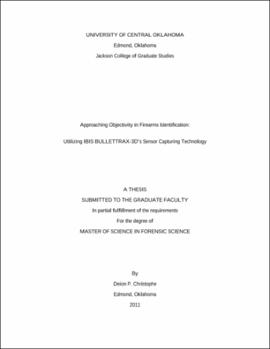| dc.contributor.advisor | Adams, Dwight | |
| dc.contributor.author | Christophe, Deion P. | |
| dc.date.accessioned | 2020-05-26T20:37:31Z | |
| dc.date.available | 2020-05-26T20:37:31Z | |
| dc.date.issued | 2011 | |
| dc.identifier.other | (AlmaMMSId)9978540085202196 | |
| dc.identifier.uri | https://hdl.handle.net/11244/324663 | |
| dc.description.abstract | Firearm examiners are often asked 1) can a bullet be matched back to the cartridge case from which it was fired? 2) What bullets leave suitable markings for microscopic examinations of this nature? 3) Is there an objective approach for interpreting firearm examiner conclusions derived from microscopic examination? For years, the inability to objectively answer questions of this nature suggests the need for further studies that offer appropriate, reliable conclusions in this discipline. The purpose of this study was to determine the possibility of identifying a bullet back to a cartridge case under both polygonal and conventional firing methods. Additional objectives were to determine which brands of ammunition produced seating marks suitable for comparison purposes, and to determine if a more objective approach for interpreting Firearm examiner identifications exists. A fixed bin analysis consisting of 53 bins in a side by side representation was utilized to analyze specific regions of interest on a single bullet's bearing surface which was acquired in 1.6mm (band) wide increments by the IBIS BULLETTRAX-3DTM system. Both qualitative and quantitative results provided by this research address concerns that have been outlined by the National Research Council (2009). The major findings in this study indicate it is possible to identify a bullet back to a cartridge case utilizing both conventional and polygonal methods of firing through use of sound methodology. This research also revealed a higher likelihood for abundant sets of striae on ammunition brands containing nickel cartridge cases. It was also established that the IBIS BULLETTRAX-3DTM system can assist examiners with better visualization and the ability to provide more objective conclusions that carry a much higher degree of certainty when conducting bullet comparisons. | |
| dc.rights | All rights reserved by the author, who has granted UCO Chambers Library the non-exclusive right to share this material in its online repositories. Contact UCO Chambers Library's Digital Initiatives Working Group at diwg@uco.edu for the permission policy on the use, reproduction or distribution of this material. | |
| dc.subject.lcsh | Bullets | |
| dc.subject.lcsh | Forensic ballistics | |
| dc.title | Approaching objectivity in firearms identification : utilizing IBIS BULLETTRAX-3D's sensor capturing technology. | |
| dc.type | Academic theses | |
| dc.contributor.committeeMember | Lord, Wayne | |
| dc.contributor.committeeMember | McCoy, Mark R. | |
| dc.thesis.degree | M.S., Forensic Science | |
| dc.identifier.oclc | (OCoLC)ocn840604590 | |
| uco.group | UCO - Graduate Works and Theses::UCO - Theses | |
| thesis.degree.grantor | Jackson College of Graduate Studies | |
